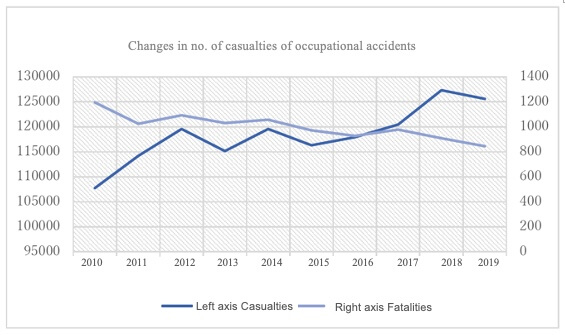[Introduction] Situation of accidents involving falls from scaffolding
1 Changes in number of occupational accidents
(1) Fortunately, the number of occupational accidents in the construction industry has been declining slightly in recent years, and the same trend has been seen in the number of accidents caused by falls.
(2) Since 2011, casualties and fatalities caused by scaffolding have accounted for about 15% and 18%, respectively, of the total number of construction industry accidents involving falls.
2 Accidents involving falls from scaffolding
(1) The construction industry accounts for approximately 90% of all fatalities and casualties. In particular, the two industries of “steel-framed reinforced concrete construction work” and “wooden house construction work” account for more than half of the total construction industry.
(2) Regarding the height of the fall site, falls occurring from a height of 2 meters or more, for which fall prevention measures are obligated by the Ordinance on Industrial Safety and Health, account for the majority of fatalities and approximately 60% of all casualties. It is important to note that in many cases, the victims were injured in falls of less than 2 meters.
(3) Looking at the work conditions at the time of the falls, about 30% were during assembly and dismantling (of which 70% were ” falls from the topmost level”), about 50% were during normal work, and about 20% were during moving and lifting. In particular, about 40% of the fatalities were caused by falls from the topmost level during assembly and dismantling, and these accidents have a high risk of resulting in death.
(4) About 90% of all accidents involving falls from scaffolding occur when the fall prevention measures stipulated in the Ordinance on Industrial Safety and Health are not properly implemented. Even in the case of accidents that occurred on scaffolding where fall prevention measures stipulated by the Ordinance on Industrial Safety and Health were properly implemented, the majority of these accidents were caused by unsteady behavior, such as leaning over, or structural problems, such as insufficiently tightened flooring or handrails.
3 Situation of Occupational Accidents in 2019
| No.of casualties | 125,611 people | (Falls 21,346 people) |
| No. of deaths | 845 people | (Falls 216 people) |
(1) Casualties by industry
| Manufacturing industry | 26,873 people | (Falls 2,973 people) |
| Construction industry | 15,183 people | (Falls 5,171 people) |
| Land freight transport business | 15,382 people | (Falls 4,279 people) |
| Tertiary industry | 60,208 people | (Falls 7,599 people) |
(2) Fatalities by industry
| Manufacturing industry | 141 people | (Falls 23 people) |
| Construction industry | 269 people | (Falls 110 people) |
| Land freight transport business | 101 people | (Falls 19 people) |
| Tertiary industry | 240 people | (Falls 48 people) |
(3) Fatalities by type of accident (a) Casualties (b) (Death rate a/b)
| Falls | 216 people | 21,346 people | (1.0%) |
| Traffic accidents (roads) | 157 people | 7,350 people | (2.1%) |
| Accidents involving getting caught or entangled |
104 people | 14,592 people | (0.7%) |
| Collisions | 77 people | 5,609 people | (1.3%) |
| Collapse | 56 people | 2,236 people | (2.5%) |
(4) Casualties of falls by cause 2017 data
| Truck | 4,680 people |
| Ladder, etc. | 4,509 people |
| Stairs and piers | 3,301 people |
| Roof, beam, etc. | 845 people |
| Scaffold | 830 people |
| Work floor, etc. | 549 people |


地域・講習・人数に合わせてすぐに予約可能
講習会を予約する受講者様のご希望に合わせ、以下のタイプの講習会もご用意しています

このページをシェアする
講習会をお探しですか?